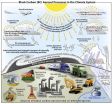(Press-News.org) Despite known risks and recommendations for protective equipment, many people are still affected with asthma after exposure to chemicals at work. This is the finding of an international study of 13,000 people carried out at the Sahlgrenska Academy, University of Gothenburg, Sweden.
Asthma is among the most common adult diseases in the world. Despite the fact that the risks of chemical exposure have long been known and that there are well-established recommendations for handling chemicals and protective equipment, many cases of asthma are still caused by exposure to toxic substances at work.
A study at Sahlgrenska Academy, University of Gothenburg, has tracked asthma cases among 13,000 randomly selected adults in Sweden, Norway, Denmark, Iceland and Estonia from 1980 to 2000. According to the study, 429 people had asthma during this period. Seven percent of cases among women were linked to workplace exposure—and among men, the number
The study found that total incidence was 1.3 asthma cases per 1,000 men, and 2.4 cases per 1,000 women.
"To be able to work proactively, it is essential to show which substances at work increase the risk of asthma and which occupations are high-risk," says Linnea Lillienberg, researcher at Sahlgrenska Academy, University of Gothenburg.
According to the study, high-risk occupations include:
spray painters, who are exposed to diisocyanates in paint
plumbers, who handle adhesives and foam insulation
cleaners, who handle detergents
health care and social services personnel, who are exposed to detergents and latex in latex gloves, especially if the gloves contain powder
food and tobacco industry workers, who are exposed to proteins from the vegetable kingdom
hair stylists, who handle chemicals in bleach and nail beauticians, who use fast-acting glue.
"Some people are more susceptible than others. For example, people with hay fever have asthma more often if they're exposed to proteins from plants and animals. But if we look at individuals with no increased susceptibility, the risk was greater among those who were exposed to epoxy and diisocyanates, which are found in glue, varnish and foam plastic. Among women without hay fever, the risk was particularly elevated among those who handled detergents," says Linnea Lillienberg.
###
The study Occupational Exposure and New-onset Asthma in a Population-based Study in Northern Europe (RHINE) was published in The Annals of Occupational Hygiene.
Contact:
Linnea Lillienberg
Sahlgrenska Academy
University of Gothenburg END
Plumber and spray painter high-risk occupations for asthma
2013-01-15
ELSE PRESS RELEASES FROM THIS DATE:
How the protein transport machinery in the chloroplasts of higher plants developed
2013-01-15
Halfway between bacteria and tree
How the protein transport machinery in the chloroplasts of higher plants developed
Moss Physcomitrella patens is an evolutionary intermediate stage
Together with colleagues from Sweden, RUB researchers have studied how the protein transport system of bacteria developed over time to form the system in the chloroplasts of higher plants. They explored the so-called signal recognition particles (SRP) and their receptors. Bioinformatic and biochemical analyses revealed that the moss Physcomitrella patens has evolutionarily old and new components ...
Designer bacteria may lead to better vaccines
2013-01-15
AUSTIN, Texas — Researchers at The University of Texas at Austin have developed a menu of 61 new strains of genetically engineered bacteria that may improve the efficacy of vaccines for diseases such as flu, pertussis, cholera and HPV.
The strains of E. coli, which were described in a paper published this month in the journal PNAS, are part of a new class of biological "adjuvants" that is poised to transform vaccine design. Adjuvants are substances added to vaccines to boost the human immune response.
"For 70 years the only adjuvants being used were aluminum salts," ...
Chemistry resolves toxic concerns about carbon nanotubes
2013-01-15
Safety fears about carbon nanotubes, due to their structural similarity to asbestos, have been alleviated following research showing that reducing their length removes their toxic properties.
In a new study, published today in the journal Angewandte Chemie, evidence is provided that the asbestos-like reactivity and pathogenicity reported for long, pristine nanotubes can be completely alleviated if their surface is modified and their effective length is reduced as a result of chemical treatment.
First atomically described in the 1990s, carbon nanotubes are sheets of ...
Born to lead? Leadership can be an inherited trait, study finds
2013-01-15
Genetic differences are significantly associated with the likelihood that people take on managerial responsibilities, according to new research from UCL (University College London).
The study, published online in Leadership Quarterly, is the first to identify a specific DNA sequence associated with the tendency for individuals to occupy a leadership position. Using a large twin sample, the international research team, which included academics from Harvard, NYU, and the University of California, estimate that a quarter of the observed variation in leadership behaviour ...
Neon lights up exploding stars
2013-01-15
An international team of nuclear astrophysicists has shed new light on the explosive stellar events known as novae.
These dramatic explosions are driven by nuclear processes and make previously unseen stars visible for a short time. The team of scientists measured the nuclear structure of the radioactive neon produced through this process in unprecedented detail.
Their findings, reported in the US journal Physical Review Letters, show there is much less uncertainty in how quickly one of the key nuclear reactions will occur as well as in the final abundance of radioactive ...
New research gives insight into graphene grain boundaries
2013-01-15
Using graphene – either as an alternative to, or most likely as a complementary material with – silicon, offers the promise of much faster future electronics, along with several other advantages over the commonly used semiconductor. However, creating the one-atom thick sheets of carbon known as graphene in a way that could be easily integrated into mass production methods has proven difficult.
When graphene is grown, lattices of the carbon grains are formed randomly, linked together at different angles of orientation in a hexagonal network. However, when those orientations ...
Facebook posts not easily forgotten
2013-01-15
Facebook posts resonate significantly more with human nature than books or even human faces, according to a new study by Laura Mickes and colleagues from the University of California San Diego in the US. The difference in memory between these microblogs and actual published words from a page is as striking as the difference in memory between amnesiacs and healthy controls. The work is published online in Springer's journal Memory & Cognition.
Online social networking is very popular, and allows people to post their thoughts as microblogs, an opportunity that people exploit ...
The muscle response of footballers depends on their position on the field
2013-01-15
Football players display different muscle response parameters depending on the position that they hold on the pitch, according to a study conducted by a team of Spanish researchers which has been published in the 'Journal of electromyography and kinesiology'.
Scientists from the University of Vigo have analysed different muscle response parameters in 78 Spanish first division footballers who have been playing for between four and fifteen years. They found variations depending on the field position of the players.
Published in the 'Journal of Electromyography and Kinesiology', ...
Black carbon larger cause of climate change than previously assessed
2013-01-15
Black carbon is the second largest man-made contributor to global warming and its influence on climate has been greatly underestimated, according to the first quantitative and comprehensive analysis of this issue.
The landmark study published in the Journal of Geophysical Research-Atmospheres today says the direct influence of black carbon, or soot, on warming the climate could be about twice previous estimates. Accounting for all of the ways it can affect climate, black carbon is believed to have a warming effect of about 1.1 Watts per square meter (W/m2), approximately ...
No panaceas for Mexico's violent drug war, but prohibition has failed
2013-01-15
While Mexico and the United States have ramped up their efforts to control and perhaps defeat Mexico's increasingly violent drug cartels, the outcome of these efforts remains in doubt and no panaceas are in sight, but prohibition has once again proved to be a failure, according to a paper from Rice University's Baker Institute for Public Policy.
The paper by Rice sociologist William Martin, "Cartels, Corruption and Carnage in the Calderón Era," traces the origins and growth of Mexican drug cartels and the corruption, failed government policies and gruesome violence ...



